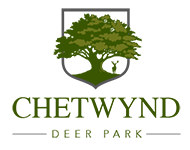Chetwynd Deer Park has an incredible history, which makes its protection and the security of its future of paramount importance to the Trustees of Newport & District Agricultural Society, which owns it today. Read on to find out more about this incredible place…
A huge depth of history

Chetwynd Deer Park was part of the Chetwynd estate, details of which are in the Domesday Book. Chetwynd was an important manor in Saxon times and was held by Leofric, Earl of Mercia, who founded Much Wenlock Priory in about 1050. His wife, Lady Godiva of Coventry fame, may have lived in an earlier Chetwynd house or hall.
The Chetwynd family itself held the manor from the 12th century and after various successions and changes in ownership, it was finally purchased by the Burton Borough family in 1803.
A visit from King Charles I
In 1645 King Charles 1 stayed three nights at Chetwynd Manor as a guest of Walter Pigott. One of the soldiers in the Kings own Lifeguard, was Captain Richard Symonds. He was keeping a diary of the events of these terrible years but also writing about the places and churches that he visited whilst accompanying the King.
He described Chetwynd Church and described the monuments to Chetwynd Knights. One monument in the chancel against the north wall “lies a knight crossed-legged, with a shield on his arme”. A cross legged knight usually denoted someone who had been a crusade and there is evidence that one of the early Chetwynds went on the first crusade, 1095 – 1099. From the 15th to the late 18th century Chetwynd was held by the Pigott Family, whom the town’s ghost story is about, namely Madame Pigott.
The last of them, Robert, High Sheriff of Shropshire in 1774, sold the estate and moved to Geneva, where he died in 1794. The estate was then purchased by Thomas Borrow, member of a Derbyshire iron-founding family, who subsequently changed their name to Borough. Thomas moved to Chetwynd in 1803, was succeeded by his son John Charles Burton, sheriff of Shropshire in 1844.
A visit from King Charles I
In 1645 King Charles 1 stayed three nights at Chetwynd Manor as a guest of Walter Pigott. One of the soldiers in the Kings own Lifeguard, was Captain Richard Symonds. He was keeping a diary of the events of these terrible years but also writing about the places and churches that he visited whilst accompanying the King.
He described Chetwynd Church and described the monuments to Chetwynd Knights. One monument in the chancel against the north wall “lies a knight crossed-legged, with a shield on his arme”. A cross legged knight usually denoted someone who had been a crusade and there is evidence that one of the early Chetwynds went on the first crusade, 1095 – 1099. From the 15th to the late 18th century Chetwynd was held by the Pigott Family, whom the town’s ghost story is about, namely Madame Pigott.
The last of them, Robert, High Sheriff of Shropshire in 1774, sold the estate and moved to Geneva, where he died in 1794. The estate was then purchased by Thomas Borrow, member of a Derbyshire iron-founding family, who subsequently changed their name to Borough. Thomas moved to Chetwynd in 1803, was succeeded by his son John Charles Burton, sheriff of Shropshire in 1844.
The development of Chetwynd Park
In the 1860s there was a major building campaign carried out by J.C.B.Borough, Chetwynd Hall was reworked as Chetwynd Park, and at the same time the church and rectory which stood in the grounds (the church just beside the hall) was demolished and replaced by new structures 250 metres to the southwest.
Terraced lawns were laid out on the site of the old church, new gardens were designed, and the park was enlarged. In the 19th century, the park was filled with deciduous trees including oak, beech, wych, elm, horse chestnuts and Spanish chestnuts, and some crab apples.
It was stocked with 115 Pere David’s deer. Before 1891, there was a great arboretum at Chetwynd, which provided cuttings to plant the new church’s drive. J.C.B.Borough also added a strip of land east of the park and north of Longford, and crated a drive to run around then outer edge of that extension, leading from Chetwynd Park to a new lodge on the Longford.
This lay opposite the north end of the park pool. There were other lodges at the south end of the pool, and at the drive to the park. The northern part of the park featured a stone icehouse, probably dating from the mid-to late 18th century.
The development of Chetwynd Park
In the 1860s there was a major building campaign carried out by J.C.B.Borough, Chetwynd Hall was reworked as Chetwynd Park, and at the same time the church and rectory which stood in the grounds (the church just beside the hall) was demolished and replaced by new structures 250 metres to the southwest.
Terraced lawns were laid out on the site of the old church, new gardens were designed, and the park was enlarged. In the 19th century, the park was filled with deciduous trees including oak, beech, wych, elm, horse chestnuts and Spanish chestnuts, and some crab apples.
It was stocked with 115 Pere David’s deer. Before 1891, there was a great arboretum at Chetwynd, which provided cuttings to plant the new church’s drive. J.C.B.Borough also added a strip of land east of the park and north of Longford, and crated a drive to run around then outer edge of that extension, leading from Chetwynd Park to a new lodge on the Longford.
This lay opposite the north end of the park pool. There were other lodges at the south end of the pool, and at the drive to the park. The northern part of the park featured a stone icehouse, probably dating from the mid-to late 18th century.
More recently…
Animals that live around the pool are Shoveler, Wigeon and occasionally Goosander. On the pool other birds of interest include all three species of Woodpecker, Nuthatch, Treecreeper, Raven, and Buzzard.
After the Borough family acquired the Chetwynd Estate, they created the Deer Park to house their existing herd of some 100 fallow deer which they brought up from Southern England. The park included open grassland, a 20 acre pool (which is a small lake considered to have been formed in the same way as nearby Aqualate mere) and some of Shropshire’s finest ancient woodland and in its heyday must have been a magnificent sight. Following the death of the life tenant, Mrs M Borough in 1987, the estate was left to Oxford University.
In 1988, the deer park was purchased by Newport & District Agricultural Society. Using their own funds and without help from an external sources, the Newport & District Agricultural Society set about the task of restoring the Park to its former glory and at the same time, creating what is acknowledged to be one of the most beautiful show grounds in the country. The society has been able to devote the surpluses generated from the shows over the years, together with funds from its Boughey Memorial Endowment, to finance the restoration of the parklands and the management of the 200 year old fallow deer herd.
From the very outset, the project has been one where the local community has been heavily involved. Indeed the massive initial ground clearance in 1989 was a joint operation between a dozen or so local volunteer farmers and their sons with tractors, trailers, diggers and dozers. The society is justly proud of what has been achieved over the last 26 years and the condition of the Deer Park is a testament to the team who look after it now. With the grasslands and woodlands actively managed and maintained and the Deer herd thriving, nature is once again the cornerstone of the Park.
The Pool Lodge, which is a listed building, has been restored to its former glory also and is a classic and rare example of the beautiful sandstone cottages which were dotted about the original estate.
As well as it been open for the Newport Show, which is held on the second Saturday in July each year, there are a number of other events held here each year. In addition, many local schools, as well as Harper Adams University visit the Deer Park for educational purposes. Although there are no public footpaths on the Deer park, there is a public footpath along the south edge of the park over a stile on the right just by Pool Lodge. This footpath leads to the B5062 road, which goes up the hill towards Edgmond.
More recently…
Animals that live around the pool are shoveler, wigeon and occasionally goosander. On the pool other birds of interest include all three species of woodpecker, nuthatch, treecreeper, raven, and buzzard.
After the Borough family acquired the Chetwynd Estate, they created the Deer Park to house their existing herd of some 100 fallow deer which they brought up from Southern England. The park included open grassland, a 20 acre pool (which is a small lake considered to have been formed in the same way as nearby Aqualate mere) and some of Shropshire’s finest ancient woodland and in its heyday must have been a magnificent sight. Following the death of the life tenant, Mrs M Borough in 1987, the estate was left to Oxford University.
In 1988, the deer park was purchased by Newport & District Agricultural Society. Using their own funds and without help from an external sources, the Newport & District Agricultural Society set about the task of restoring the Park to its former glory and at the same time, creating what is acknowledged to be one of the most beautiful show grounds in the country. The society has been able to devote the surpluses generated from the shows over the years, together with funds from its Boughey Memorial Endowment, to finance the restoration of the parklands and the management of the 200 year old fallow deer herd.
From the very outset, the project has been one where the local community has been heavily involved. Indeed the massive initial ground clearance in 1989 was a joint operation between a dozen or so local volunteer farmers and their sons with tractors, trailers, diggers and dozers. The society is justly proud of what has been achieved over the last 26 years and the condition of the Deer Park is a testament to the team who look after it now. With the grasslands and woodlands actively managed and maintained and the Deer herd thriving, nature is once again the cornerstone of the Park.
The Pool Lodge, which is a listed building, has been restored to its former glory also and is a classic and rare example of the beautiful sandstone cottages which were dotted about the original estate.
As well as it been open for the Newport Show, which is held on the second Saturday in July each year, there are a number of other events held here each year. In addition, many local schools, as well as Harper Adams University visit the Deer Park for educational purposes. Although there are no public footpaths on the Deer park, there is a public footpath along the south edge of the park over a stile on the right just by Pool Lodge. This footpath leads to the B5062 road, which goes up the hill towards Edgmond.
Get your Show tickets today
Beat the rush and secure your tickets here.



